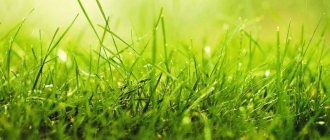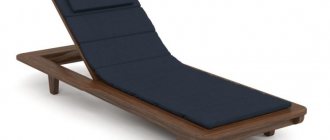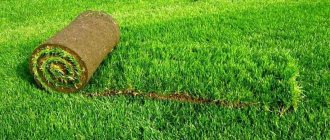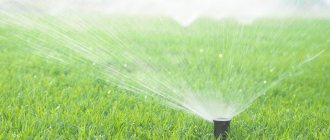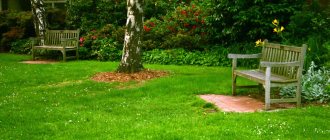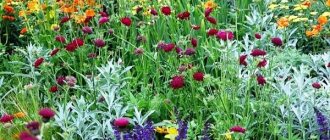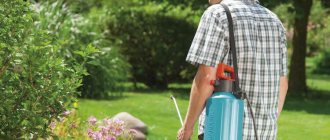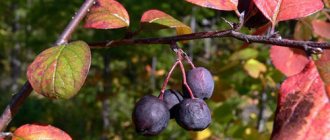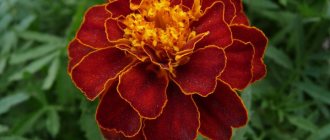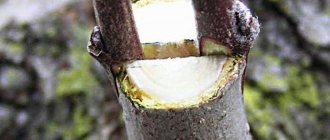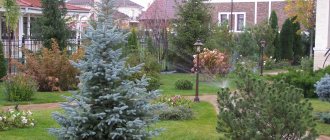Purpose of rolled lawn, types
To quickly and without hassle turn a bare piece of land into a green lawn is the main purpose of lawn rolls. With its help, you can decorate any area in your garden, in a park or on city streets. Such grass needs 7-10 days to take root, after which it can be walked on. The main thing is to choose the right type and prepare the area for installation.
The basis of the lawn is always bluegrass with a slight inclusion of fescue, bentgrass or hedgehog grass. There are several varieties of these herbs. Some have a powerful root system that can produce shoots even in waterlogged areas. There are species with dense, wide foliage and growing up to 90 cm in height. The choice of variety depends on climatic conditions and the type of lawn. One roll on average measures 40 cm wide and 2 m long. Thickness is about 8-10 cm.
Types of rolled lawn:
- classic or universal - the most durable and viable option, with the help of which complex landscapes are designed. It tolerates shade well, is resistant to drought and trampling. Suitable for the city and private homes;
- ground floor - has excellent external characteristics, but does not tolerate loads. Requires special care knowledge. Its purpose is decoration, not exploitation;
- sports – resistant to trampling, quickly recovers. Suitable for decorating football fields, golf courses, playgrounds. Requires frequent feeding and haircuts.
The lawn is chosen depending on the purpose of the area on which it will be laid Source gazon-premium.ru
There are other types of lawn with a narrower purpose, for example, to decorate the coastal zone of a reservoir or strengthen a slope. The price of a universal lawn is the most affordable and depends on the cost of the entire range of cultivation and installation work. The most expensive is the ground lawn, followed by the sports lawn. They consist of a mixture of elite herbs and require more effort to grow.
See also: Catalog of companies that specialize in landscape design work.
Herbal mixtures used for lawns
Seeds for planting are usually taken from such types of cereal grasses as: perennial ryegas, some types of fescue, bentgrass, and bluegrass. The combination of fescue and bluegrass in a mixture is considered balanced. They complement each other perfectly.
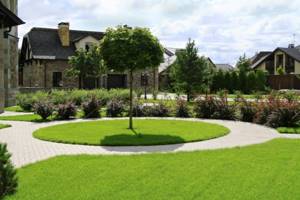
In hot weather, the fescue towers above the bluegrass, which has folded its leaves, and if it gets colder, the bluegrass blooms them in all its glory. Fescue has established itself as an unpretentious, hardy grass that is little susceptible to disease, it tolerates hot weather well and can grow in the shade.
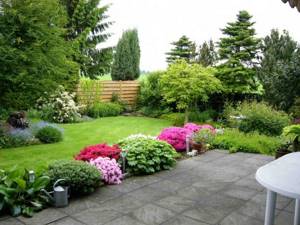
Meadow bluegrass is more demanding of care. With insufficient attention to itself (untimely watering or mowing), it loses its color saturation. This plant loves sunny areas, but begins to wither in the shade. But bluegrass is quite frost-resistant. With optimal care, such a lawn will delight you for several decades.
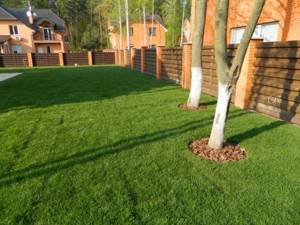
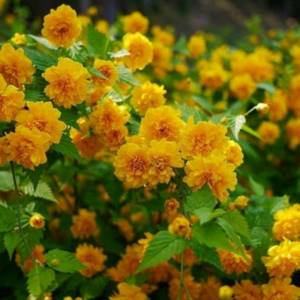
Kerria or Keria: photo and description of the shrub, rules and subtleties of growing a plant with yellow flowers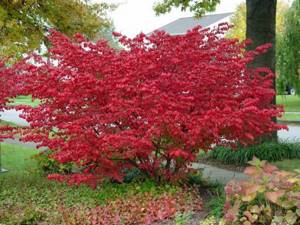
Ornamental shrubs in landscape design blooming in autumn
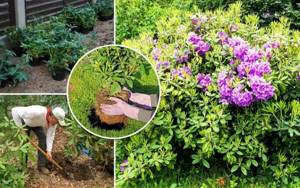
Autumn planting of shrubs: useful tips from experienced gardeners
The lifespan of rygas, a plant that is often included in lawn mixtures, is about 3 years. It is included in the composition because it has rapid germination and bright color.

The lawn on which one rygas is planted is short-lived; at first it bushes, which looks untidy, and after two years it begins to thin out. This happens at any sowing density; the reason is the lack of rhizomes.
Bentgrass is also used in lawns, especially golf courses. This plant often gets sick and responds poorly to insufficient care. When there is an excess of it in the mixture, bentgrass fills the entire space, displacing other herbs.

Advantages and disadvantages
It is difficult to grow a beautiful, viable lawn without special skills. In addition, the process takes about 2 years so that you can safely walk around the sown areas and admire their beauty. During this time, young greenery is carefully looked after: watered regularly, fed with fertilizers depending on the season and type, and cut.
In order not to waste time and energy, many decide to buy lawn in rolls, because it has many advantages :
- creates an ideal cover ;
- does not contain weeds;
- quickly takes root and takes root;
- ready for use 1-2 weeks after installation.
This lawn has optimal density, is resistant to local climatic conditions, and does not require overseeding. Another advantage is the ability to design a plot at any time from early spring to late autumn.
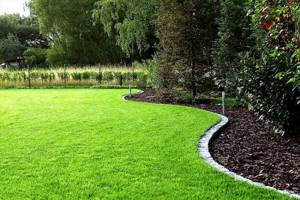
Unlike sowing, a rolled lawn already in the first week adds aesthetics to the landscape of the site. Source gazon-premium.ru
The only disadvantage of such a product is the cost. If the grass is grown by good specialists and laid on the site within 72 hours, the ideal appearance of the landscape is ensured. The only difficulty that a site owner faces when laying rolls on their own is proper soil preparation. To avoid problems and save time, the lawn is ordered along with its installation services. Typically, a full range of turnkey services implies good discounts.
Selection of grasses for roll coating
The characteristics of plants make it possible to grow lawns with different functional purposes. The characteristics of a rolled lawn depend on the composition of the greenery. Some plants do not allow weeds to break through, others have increased germination, others are resistant to frost or drought, others are easily restored, others are unpretentious in care, etc.
For these reasons, mixtures of plant seeds in different proportions are used to grow grass in rolls. The composition of the proportions of the mixture depends on the further use of the lawn. The most common:
- 10% ryegrass, 30% fescue and 60% bluegrass - this mixture is considered universal, and a lawn grown from this mixture can be used both as landscaping and for outdoor activities. These greens do not require complex care;
- 20% bluegrass and 80% fescue - such a meadow feels good in the shade, the greenery does not wither and is not afraid of rotting. The mixture is not suitable for use on children's and sports grounds. Greens in these proportions require special care.
- 25% fescue, 25% ryegrass and 50% bluegrass - a mixture that allows plants to quickly recover after active time on the lawn.
Production technology
To grow a high-quality, beautiful lawn, production technology with the optimal choice of seed material is strictly followed. Each type of herb is grown in the conditions to which it is adapted. So, a shady lawn is grown only in the shade, because its main function is to decorate shady areas of the garden.
Nursery employees maintain a special density of sowing seeds, ideally level the area, apply fertilizers, and regulate the watering regime. Before sowing, be sure to treat the area with herbicides so that weeds do not break through the lawn and interfere with the full development of the root system.
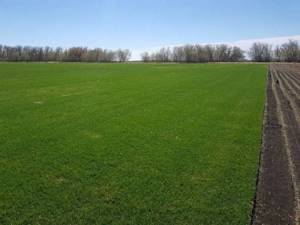
Before getting onto the site, the rolled lawn goes through several stages of cultivation Source seattlehelpers.org
The following production stages :
- application of fertilizers with a high nitrogen content;
- light compaction of the area, moistening;
- sowing seeds;
- second compaction and watering .
On average, it will take 1.5 years to grow a lawn ready for cutting and transportation. During this time, nursery staff carry out haircuts, feed, water the plants, and aerate the soil in spring and autumn, achieving the ideal combination of cover density and resistance to weather conditions. That is why the price of rolled grass for a lawn starts from 85 rubles. per m2.
When the lawn is fully formed, has a strong root system and healthy greenery, it is trimmed with special machines, rolled up and transported. Ideally, it is laid within the first 2 days, but in humid conditions it can be stored for 4 days. The thickness of the layer of turf with greenery is approximately 8 cm, so when preparing the site for laying it, the ground level is set lower by 7-8 cm.
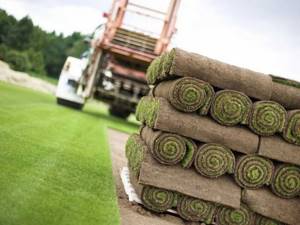
Rolls ready for sale and transportation Source mirgazon.ru
Organizations involved in growing lawn grasses usually offer the following set of additional services :
- site preparation with soil composition analysis;
- replacing soil if it is not suitable;
- leveling , compaction;
- laying rolls according to the scheme, followed by fixing and watering.
Nursery specialists can lay the roll on the already prepared surface of the site.
Elite lawn
Represented by bluegrass - a soft and juicy grass. Highly decorative. Characteristics:
- absence of weeds;
- high cost;
- demands on regularity of watering;
- drought intolerance.
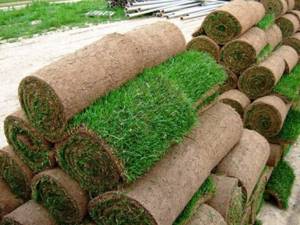
This is the best rolled lawn.

Method of laying rolled lawn
To obtain an ideal green landscape in a short time, it is important to properly prepare it for laying the lawn. This is the first stage of work. It includes:
- plowing or digging up the soil at least 10 cm;
- removal of weeds and treatment with broad-spectrum herbicides;
- leveling with a slope of 3-5 cm to drain excess water;
- compaction , application of nitrogen fertilizers and watering.
Lawn grasses love slightly acidic soil, so if its Ph is far from ideal, the necessary substances are added to the soil. Acidic, calcareous, alkaline soil is acidified by adding peat or other components. A good lawn requires sandy or sandy loam soil types. Grains grow poorly on heavy clay soils, so the soil is diluted with sand.
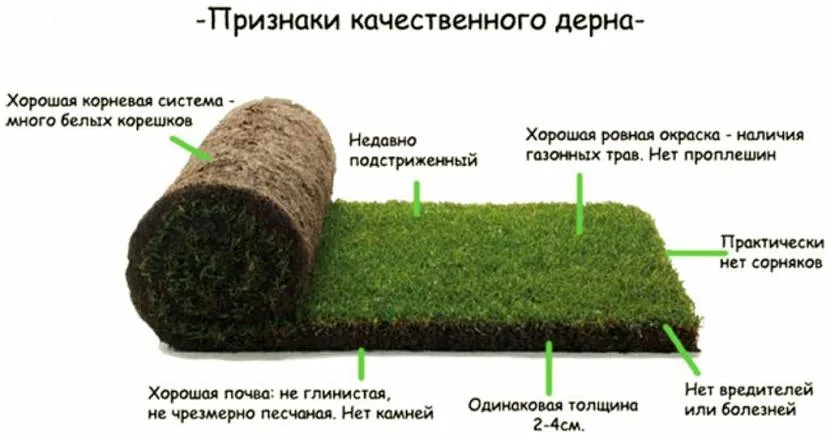
The lawn ready for laying must meet certain quality criteria Source lanshaft.com
At the second stage, the rolls are laid out on the site in a checkerboard pattern and laying begins, starting from a right angle. It is important to pack the rolls tightly here. The edges of the lawn should not overlap one another. Some areas are secured with pegs. In areas of different configurations, unnecessary parts of the roll are cut off with a sharp knife.
At the third stage, the lawn is lightly rolled so that the roots are in close contact with the ground and the plants quickly take root. Watering is required. Once installed, rolled lawn grass requires daily watering for a week. After a maximum of 2 weeks, you can walk around the area.
In recent years, nurseries that specialize in the production of rolled turf have begun to use the technology of growing on plastic mesh. It is laid on top of the site, the seeds are sown and covered with a thin layer of soil, followed by rolling. The root system of young shoots entwines the mesh cells and is tightly fixed. This is the meaning of the new technology. The result is a dense lawn base that does not deform during transportation and allows you to reduce the time for growing. Using this technology, the lawn is ready within 1 year.
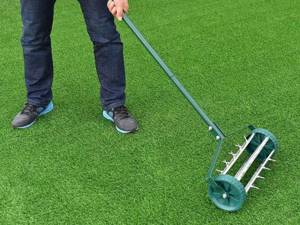
Any lawn requires attention and care Source instagram-dm.com
Criteria for the quality of grass surfaces
Rolled lawn is available in a standard size, convenient for transportation and planting (2x0.4 m). The turf layer is only 1.8-2.5 cm with a grass height of up to 7 cm. A high-quality lawn should be dense without bald spots and weeds. When unfolded, the plant web does not break through or become deformed, and many white roots are visible on the branched root system. One roll weighs approximately 16-25 kg.
When choosing a grass cover, you should carefully inspect the roll. Preference should be given to specimens with a uniform turf layer, free of debris and stones. The soil composition should contain a minimum of sand and clay. If signs of damage to grass blades or roots by pests are found, it is better to refuse the purchase. The ideal option would be a roll that has been recently trimmed by a mower.
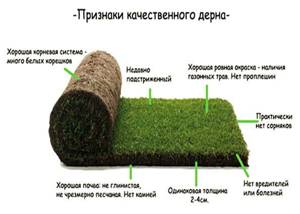
Rules of care
The lawn is planted. To ensure that it looks presentable throughout the warm season and comes out green from under the snow, it is carefully looked after. In the first weeks after installation, use it sparingly. Picnics and active games can harm greenery and roots that have not yet matured. Water the area 2-3 times a week, 10 liters per m2. In spring, haircuts are done once a week, in summer - 2 times a week.
From April to August, nitrogen fertilizers are applied once every 2 weeks. In autumn, to increase the winter hardiness of grasses, potassium fertilizers are added along with watering. The soil is aerated twice a year to improve oxygen supply to the roots. This is done with special aerators, piercing the turf to a depth of 10 cm. There are manual aerators for personal plots and mechanized ones for industrial use. The delicate emerald green of the lawn is the result of proper systematic care, which allows the lawn to exist for many years.
Standard lawn
In addition to bluegrass, the composition contains fescue. It is resistant to various natural influences. In demand in landscape design of dachas.
How to care
Roll lawn should be planted in spring or early summer. This is the only way he will have enough time to adapt before the onset of winter cold.
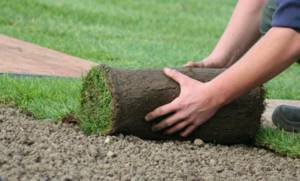
To ensure that the decorative qualities of the green carpet do not deteriorate over time, it is necessary to follow a number of recommendations:
- Apply nitrogen or mineral fertilizers annually in May.
- During the warm season, mow the lawn twice a month and feed it with nitrogen and phosphorus.
- Do not forget to use phosphorus-potassium fertilizer at the end of summer. Apply herbicide treatments regularly throughout the season.
- All green maintenance work must be completed by November. Get your last haircut in October. Remove fallen leaves and debris.
- In the spring, after the soil has dried, get rid of yellowed felt grass by walking over the lawn with a fan rake.
Technical lawn
Purpose – improvement of public areas. Consists of bluegrass, fescue, timothy.
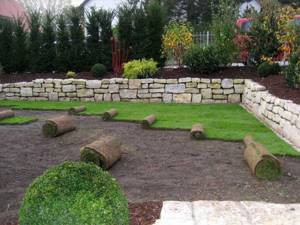
The grass mixture may also include other cereal plants. This is the most affordable type of lawn from a financial point of view, since it can contain weeds.

